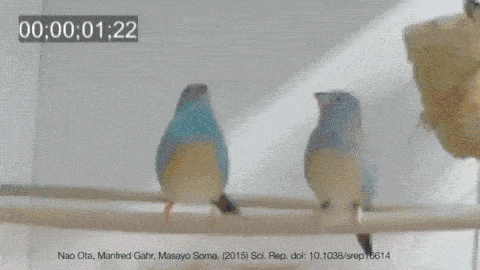
There are quite a few tactics employed by animals in nature to woo mates. You can be aggressive and forcefully take a mate, cave-man style. You can peacock, and display yourself as elegant and resourceful. Or you can dazzle your partner with showmanship. A lot of birds vocalize beautiful songs (or so they sound) to attract a mate. Typically a male does the work and the female gets to pick her favorite. Blue-capped cordon-bleus, however, not only sing, but tap-dance as well. Moreover, both males and females do it, and it seems like a lot of fun. These dances are so quick that you’ll miss them with the naked eye. If you’re looking for the lord of the dance, set your gaze high up the branches.
Researchers from Japan and Germany discovered this unique tap-dancing ritual after painstakingly recording the songbirds using high-speed cameras. The team followed eight pairs of cordon-bleus over multiple two-hour sessions. Sometimes, the birds were unresponsive since these didn’t enjoy each other’s company. The researchers had to be very patient and creative in choosing their pairs. Once the birds felt comfortable, both males and females would start to bop up and down. Once both were on the same perch, the dance became more vigorous which caused discernible vibrations.
This is the first bird, that we know of, that uses its feet to produce non-vocal sounds. Elsewhere, researchers have found some birds use their wings to deliberately produce non-vocal sounds, but typically these birds don’t sing. Masayo Soma, from Hokkaido University in Japan says these vibrations a musical accompaniment to the bird’s song, targeting multiple senses. Previously, researchers at Hokkaido University in Japan male Java can coordinate their bill-clicking sounds with the notes of their song, adding a drum-like beat to the chirp-chirp tune.
“It is very astonishing,” said Manfred Gahr, co-author of the study, from the Max Planck Institute for Ornithology in Germany. “Maybe more birds are doing it, but it just has not been seen.”
From the videos, the researchers could tell each cordon-bleu could make three or four very rapid steps. As little as 20 milliseconds (0.02 seconds) passed between each step, the researchers reported in Scientific Reports. Literally as fast as the blink of an eye. Check out the cordon-bleus amazing dance below.







